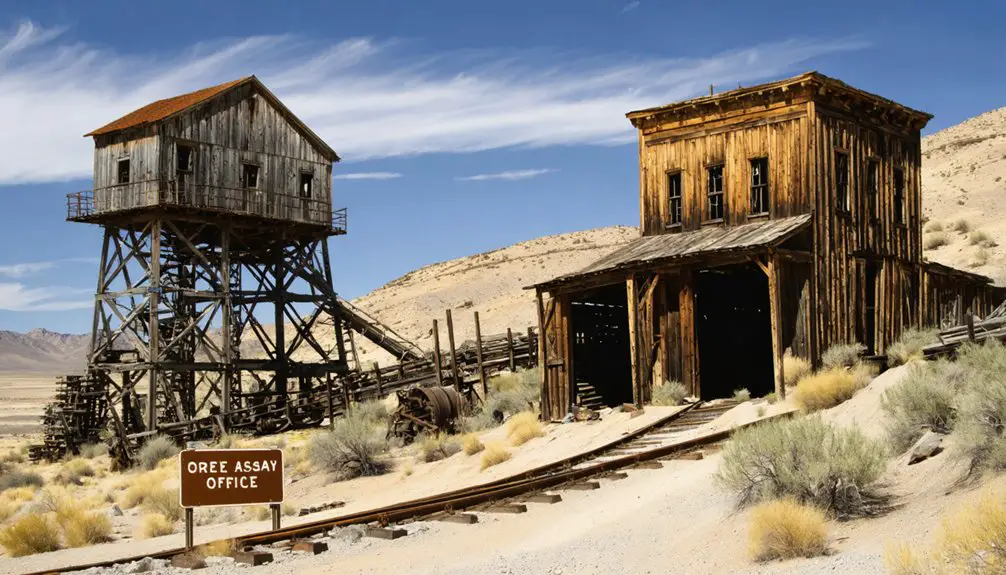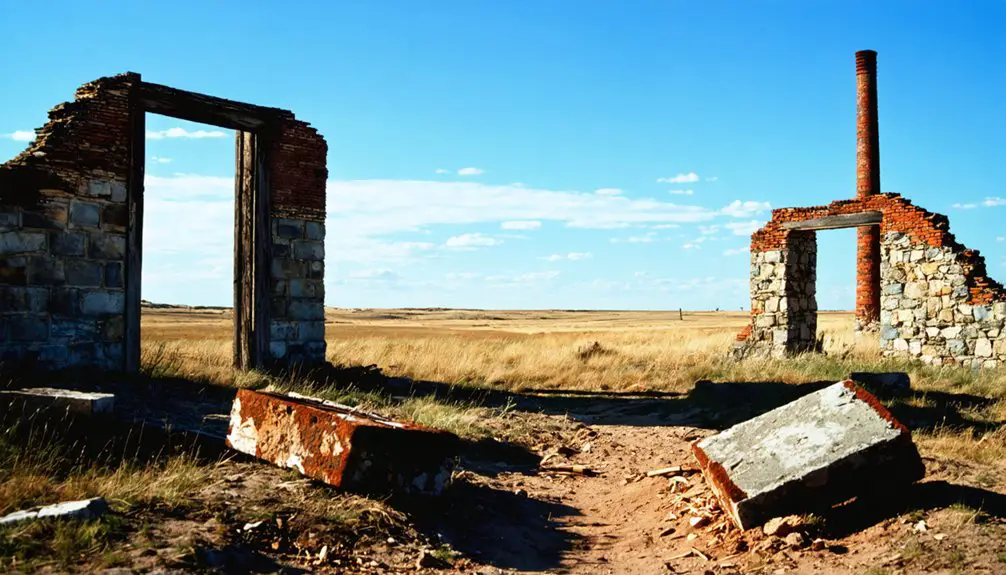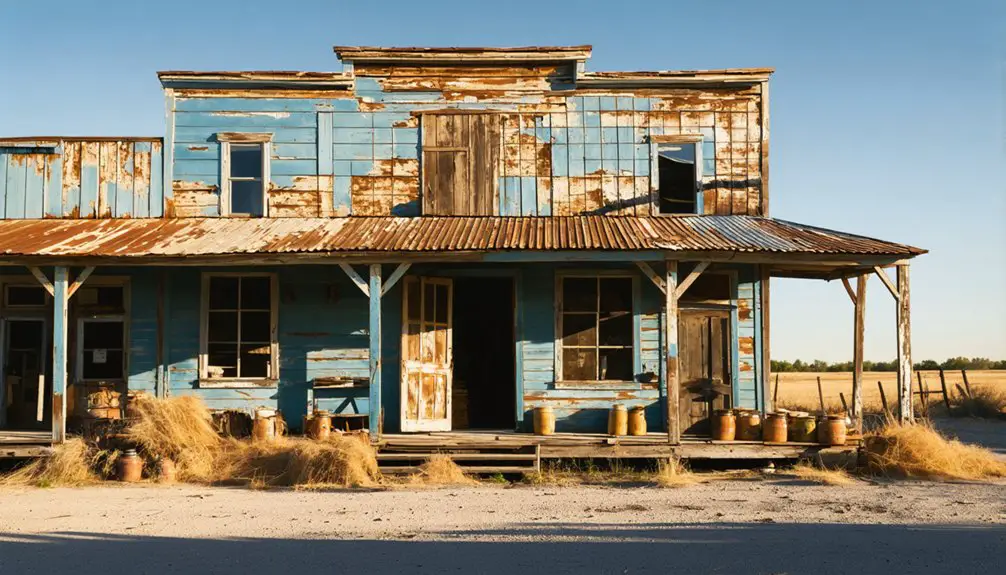You’ll find Vernon’s weathered remains in Pershing County, Nevada, where this once-bustling mining town emerged in 1905 to support gold operations in the Seven Troughs district. At its peak, Vernon housed 600 residents and boasted rich ore yields of $600 per ton. By 1926, most structures relocated to nearby Tunnel Camp as mining fortunes shifted. Today, you’ll discover decaying wooden buildings and mining artifacts that tell a fascinating story of Nevada’s second gold rush.
Key Takeaways
- Vernon was established in 1905 as a mining support town in Nevada’s Seven Troughs district, reaching a peak population of 600 residents.
- The town thrived between 1905-1907 with two 10-stamp mills processing high-grade gold ore worth $600 per ton.
- By 1913, Vernon’s population dropped to 50 people as ore deposits depleted, with mining operations ending around 1910.
- Most buildings were relocated to nearby Tunnel Camp in 1926, where a drainage tunnel project attempted to revive mining operations.
- Today, visitors can explore weathered wooden structures and mining remnants at both Vernon and Tunnel Camp sites.
The Birth of a Mining Town
As prospectors discovered rich gold deposits in Nevada’s Seven Troughs district, the town of Vernon emerged in 1905 as an important support base for the region’s burgeoning mining operations.
The town founding marked a strategic response to the area’s untapped mineral wealth, with over 100 mining claims staked in the surrounding mountains. Like many entries in place name disambiguation, Vernon became a significant location in Nevada’s mining history. Some of its buildings were relocated to support the development of nearby Tunnel Camp in 1927.
Mining claims multiplied across Nevada’s peaks as Vernon emerged to tap the region’s vast underground riches.
You’ll find Vernon’s original site northwest of Lovelock in Pershing County, perched at 4,646 feet elevation.
The town quickly established itself as a crucial hub, culminating in the opening of its post office in October 1906.
At its peak, you’d have encountered about 600 residents, drawn by gold ore so rich it yielded $600 per ton.
This prosperity drove the construction of processing mills and important infrastructure, transforming Vernon into a proper frontier mining town.
Peak Years and Prosperity
You’ll find Vernon’s peak prosperity between 1905-1907 reflected in its rapid expansion of services, including schools, hotels, and multiple saloons serving a population that swelled to 600 residents.
The town’s economic importance centered around two 10-stamp mills that processed high-grade ore yielding up to $600 per ton, attracting merchants and bankers who established thriving businesses. Vernon was part of a network of three mining boomtowns that supported the area’s gold mining operations.
The establishment of the post office in 1906 marked another milestone in Vernon’s development as a significant mining community.
Gold Rush Commerce Boom
When Vernon’s gold deposits were discovered in the early 1900s, the town rapidly transformed into a bustling commercial hub during Nevada’s second mining boom.
You’d have found a thriving ecosystem of businesses catering to the influx of miners and prospectors – from supply stores and assay offices to hotels and saloons. The miners extracted gold from hydrothermal veins that formed in fault zones and shear zones.
The gold mining operations sparked substantial economic growth, with property values soaring and wealth flowing into local commerce. The town’s peak coincided with the Tonopah-Goldfield period that began in 1901, marking an era of intensive precious metals extraction across Nevada.
Town Services Expand Rapidly
The rapid establishment of Vernon’s municipal services mirrored its commercial growth during the gold rush years.
You’ll find evidence of this service expansion in the town’s first post office, which opened in October 1906, just months after Vernon’s founding.
By mid-1907, as the population swelled to 600, the town met growing community needs with essential infrastructure including a two-cell jailhouse for law enforcement.
The mining boom drove development of ore processing facilities and supply chains, while the expanding population required water wells, defined street layouts, and commercial buildings.
You can trace Vernon’s prosperity through its municipal planning, marked by the Humboldt County Commissioners’ acceptance of the townsite expansion in September 1906, which set the framework for organized civic development.
The nearby town of Mazuma washed away in a devastating 1912 flood that claimed nine lives.
Despite the initial prosperity, the population declined sharply to 300 residents by late 1907.
Banking and Business Growth
During Vernon’s peak years of 1907-1908, a sophisticated financial infrastructure emerged to support the town’s booming mining economy.
You’d find a local bank handling mining claims and ore sales, while a stock exchange facilitated investments throughout the Seven Troughs district. Banking trends reflected the town’s evolution from a mining camp to a legitimate commercial center.
Business diversification flourished as Vernon’s population reached 600 residents. Like many mining towns, access to sufficient water supplies was crucial for ore processing operations.
You could access multiple newspapers, restaurants, and mercantile shops. The town’s commercial landscape included a hotel, doctor’s office, and various hospitality venues.
Mining profits of $600 per ton from high-grade ore fueled this expansion, while two 10-stamp mills boosted processing capacity.
The town’s administrative role, including a centralized jail and miner’s union hall, reinforced its position as the district’s commercial hub.
Life in Early Vernon
As mining opportunities drew fortune seekers to Vernon in the early 1900s, the town’s population swelled to roughly 600 residents by 1907, creating a bustling community centered around mineral extraction.
You’d find miners and their families establishing daily routines around the mining shifts, while support workers kept the town’s essential services running. Community gatherings often took place in the town’s saloons, where you could exchange news and socialize after long days of work.
The wooden buildings that lined Vernon’s streets housed mercantile shops, schools, and other basic services you’d need for frontier living.
While life wasn’t luxurious, you’d have found the necessities – mail service through the local post office, education for your children, and the camaraderie of fellow prospectors seeking their fortunes in Nevada’s rugged terrain.
Mining Operations and Gold Rush

While fortune seekers flocked to Vernon in 1905, the town primarily served as a commercial hub for the Seven Troughs mining district rather than a major mining site itself.
The district’s gold extraction focused on gold and silver-lead ores, with mining techniques including dry-washing and sluicing operations. A devastating 1912 flood destroyed much of the mining infrastructure in the area.
The nearby Nevada Wonder mine proved particularly lucrative, returning over $1.5 million in dividends to investors. Mining operations lasted only 3-4 years before the ore deposits were largely depleted by 1910.
You’ll find that Vernon’s infrastructure supported these endeavors through the Vernon Water, Light and Power Co., established in 1907.
Despite a later attempt to revive mining through the Tunnel Camp initiative in 1927, which aimed to access old mine shafts, the project failed by 1934.
The Rise of Tunnel Camp
As mining operations shifted northward in 1927, you’ll find that most of Vernon’s buildings were dismantled and relocated to establish Tunnel Camp, a new company town built by the Nevada State Mining Company.
The relocated structures supported an ambitious tunnel drainage project that aimed to replicate the success of the earlier Sutro Tunnel concept.
Your exploration of Tunnel Camp’s remains reveals how engineering miscalculations in the tunnel’s alignment by 1929 ultimately doomed both the project and the camp’s future, leading to its abandonment by 1934.
Mining Operations Shift North
When Vernon’s mining fortunes declined in the early 1910s, activity shifted two miles north to the newly established Tunnel Camp in 1926. This mining shift marked a strategic change in operations, as companies sought to address underground water issues through an ambitious drainage tunnel project.
The operational alteration from Vernon to Tunnel Camp included:
- Relocation of existing buildings from Vernon to the new camp site
- Construction of a massive 100-ton Friedman ball mill and cyanide plant by 1930
- Development of three separate ore processing facilities
- Investment of over $3 million in new infrastructure and tunnel construction
You’ll find that while Tunnel Camp never grew into a proper town, it remained active longer than Vernon, with some operations continuing until 2000.
The camp’s ruins today include well-preserved mill foundations, a brick office, and several intact cabins.
Buildings Relocated From Vernon
The ambitious relocation of Vernon’s buildings to Tunnel Camp in the late 1920s marked a defining chapter in the district’s mining history.
You’ll find that nearly every structure from Vernon – homes, bunkhouses, stores, and company offices – made the journey north, establishing essential community infrastructure at the new site.
The careful building preservation efforts included innovative environmental modifications.
Workers planted trees around the relocated structures, using tunnel drainage water for irrigation. This thoughtful approach helped Tunnel Camp grow to roughly 30 buildings, creating a more livable environment than typical mining camps.
As Vernon’s buildings found new life at Tunnel Camp, they formed the backbone of a thriving mining operation.
The move effectively ended Vernon’s existence while cementing Tunnel Camp’s position as the district’s primary settlement.
Failed Tunnel Project Dreams
Despite ambitious plans to construct a 2.5-mile drainage tunnel, Tunnel Camp’s establishment in late 1926 marked the beginning of a costly and ultimately unsuccessful mining venture.
The project’s tunnel failures and economic setbacks can be traced through these critical events:
- Initial progress was painfully slow, with only 506 feet completed by 1926.
- By 1929, workers discovered alignment errors that forced them to retreat hundreds of feet.
- At 10,000 feet, they realized the tunnel’s improper angle prevented connection to essential mine shafts.
- The project’s abandonment in 1934 came after massive expenses yielded no practical mining benefits.
You’ll find this venture’s remnants preserved in the camp’s ruins today, standing as a reflection of the ambitious yet misguided attempt to revitalize Seven Troughs’ mining operations through advanced drainage systems.
Decline and Abandonment
Founded in 1905 as a mining settlement, Vernon experienced dramatic population shifts that foreshadowed its eventual abandonment.
At its peak in 1906-1907, you’d find about 600 residents chasing mining fortunes, but this population migration quickly reversed as ore deposits depleted. By 1913, only 50 people remained, and the post office’s closure in 1918 marked the town’s effective death knell.
Vernon’s dramatic population collapse tells a stark tale: 600 hopeful miners in 1907 dwindled to just 50 by 1913.
Vernon’s mining legacy came to an abrupt end as operations ceased around 1910, leaving behind a stark economic void.
When Tunnel Camp emerged two miles north in 1927, residents relocated many of Vernon’s wooden buildings there, further cementing the town’s demise.
Geographic isolation, lack of railroad access, and obsolete mining methods sealed Vernon’s fate, transforming it into the ghost town you’ll find today.
What Remains Today

Today’s visitors to Vernon encounter a landscape marked by weathered wooden structures and mining remnants that tell the story of its brief but vibrant past.
The ghostly atmosphere pervades both the original townsite and nearby Tunnel Camp, where many of Vernon’s buildings were relocated in 1927. You’ll discover historical remnants scattered across both locations, creating a preserved snapshot of Nevada’s mining era.
Here’s what you’ll find at these sites:
- Wooden residential and commercial structures standing after 100+ years
- Mining artifacts including shafts, ore dumps, and equipment fragments
- A collection of about 30 buildings at Tunnel Camp, including bunkhouses and a brick mine office
- Environmental traces of mining operations, from tailings piles to drainage channels
The dry climate has helped preserve these structures, though they continue to naturally decay without active preservation efforts.
Historical Impact on Nevada Mining
The emergence of Vernon in 1905 marked a significant chapter in Nevada’s early 20th-century mining expansion.
You’ll find that Vernon’s story reflects the economic fluctuations that defined Nevada’s mining towns – growing from nothing to 300 residents by 1907, then declining as ore deposits dwindled by 1910.
The town’s legacy extends beyond its brief heyday through Tunnel Camp‘s ambitious 1927 engineering project.
This technological advancement, though ultimately unsuccessful, demonstrated how mining technology evolved to tackle challenging deposits.
While smaller than famous sites like the Comstock Lode, Vernon’s contribution to Nevada’s mining industry showcases the era’s pioneering spirit.
The town’s rise and fall exemplifies how mineral discoveries drove the state’s development, leaving behind both economic lessons and environmental challenges that shape modern mining practices.
Frequently Asked Questions
Were There Any Major Crimes or Notable Lawmen in Vernon?
Despite having a two-cell jailhouse, you won’t find records of major Vernon crime or notable lawmen. The town’s brief mining era left little evidence of significant criminal activity or law enforcement heroes.
What Happened to the Bank’s Assets When Vernon Was Abandoned?
You’ll find the bank’s assets were methodically liquidated around 1910, with John Cook selling fixtures and marble floors while financial assets likely dissolved during the mass exodus and economic collapse.
Did Any Famous People Ever Visit or Live in Vernon?
You won’t find any famous visitors or historic residents documented in Vernon’s short history. No celebrities called it home, and no notable figures passed through during its brief 1905-1918 mining period.
What Were the Typical Wages for Miners Working in Vernon?
You’d have earned $3-$5 daily as a Vernon miner in the late 1800s, totaling $75-$125 monthly. These mining wages represented strong economic impact compared to other local jobs.
Were There Any Schools or Churches Established in Vernon?
You’ll find Vernon had a bustling eight-room school serving 324 students in 1908, but it burned down in 1932. While educational facilities existed, there’s no confirmed evidence of religious institutions in town.
References
- https://en.wikipedia.org/wiki/Vernon
- https://nvtami.com/2021/12/30/tunnel-camp-nevada-ghost-town/
- https://www.nvexpeditions.com/pershing/vernon.php
- https://travelnevada.com/ghost-town/seven-troughs-ghost-town/
- https://www.nevadaghosttownsandmininghistory.com/portfolio-2/vernon
- https://www.nevadaappeal.com/news/2019/sep/04/tunnel-camp-boasts-short-life-but-long-history/
- https://www.youtube.com/watch?v=eMc3JzSbD6k
- https://experience.arcgis.com/experience/0cceabadda7c4243a5f45d2957dc8ca3
- https://ronhess.info/docs/report7_history.pdf
- https://nbmg.unr.edu/mining/MiningHistory.html



